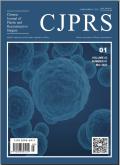Solcoseryl-enriched biodegradable diplene membrane for lower eyelid reconstruction: A novel bioactive approach
Chinese Journal of Plastic and Reconstructive Surgery
Pub Date : 2025-06-01
DOI:10.1016/j.cjprs.2025.05.003
引用次数: 0
Abstract
Background
The full-thickness excision of malignant lower-eyelid tumors, particularly those with posterior lamellar involvement, presents a reconstructive challenge. Traditional grafts often have limitations, prompting interest in biocompatible alternatives, such as biodegradable diplene membranes. This study introduces a novel modification to the standard protocol: the use of diplene membranes enriched with Solcoseryl, a metabolically active agent that enhances angiogenesis, reduces inflammation, and accelerates epithelialization.
Methods
Twenty-seven patients (mean age, 68.96 ± 8.09 years) with histologically confirmed malignant lower-eyelid tumors underwent reconstruction using diplene membranes combined with Solcoseryl. The outcomes were compared with those of a previously reported cohort treated with Diplene alone. The follow-up period ranged from 3 to 12 months.
Results
All patients achieved successful restoration of eyelid support with high aesthetic satisfaction. The Solcoseryl group demonstrated significantly faster epithelialization (mean 9.8 ± 1.2 days), improved microcirculatory parameters, and no serious complications. Minor hematomas occurred in two cases (7.4%).
Conclusion
The modified Diplene–Solcoseryl membrane enhanced wound healing and biocompatibility during lower-eyelid reconstruction by transforming the membrane into a bioactive scaffold. This innovation offers superior functional and aesthetic outcomes compared to standard diplene use and represents a significant advancement in oculoplastic and oncological reconstructive surgery.
富含solcoseryl的可生物降解双膜下眼睑重建:一种新的生物活性方法
背景:恶性下眼睑肿瘤的全层切除,尤其是累及后板层的肿瘤,是一个重建的挑战。传统的移植物通常有局限性,这促使人们对生物相容性替代品的兴趣,如可生物降解的双膜。本研究引入了对标准方案的一种新的修改:使用富含Solcoseryl的双膜,Solcoseryl是一种代谢活性物质,可以促进血管生成,减少炎症,加速上皮化。方法对27例经组织学证实的下眼睑恶性肿瘤患者(平均年龄68.96±8.09岁)行双膈膜联合索可赛利重建术。这些结果与先前报道的单用Diplene治疗的队列进行了比较。随访时间为3 ~ 12个月。结果所有患者眼睑支撑修复成功,美观满意度高。Solcoseryl组表现出明显更快的上皮化(平均9.8±1.2天),微循环参数改善,无严重并发症。2例发生轻微血肿(7.4%)。结论经修饰的双戊烯-索可丝酰基膜通过将膜转化为生物活性支架,促进了下眼睑重建术中创面的愈合和生物相容性。与标准的双双使用相比,这种创新提供了优越的功能和美观的结果,代表了眼科整形和肿瘤重建手术的重大进步。
本文章由计算机程序翻译,如有差异,请以英文原文为准。
求助全文
约1分钟内获得全文
求助全文
来源期刊

Chinese Journal of Plastic and Reconstructive Surgery
Surgery, Otorhinolaryngology and Facial Plastic Surgery, Pathology and Medical Technology, Transplantation
CiteScore
0.40
自引率
0.00%
发文量
115
审稿时长
55 days
 求助内容:
求助内容: 应助结果提醒方式:
应助结果提醒方式:


